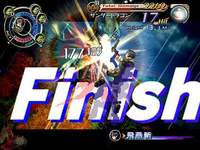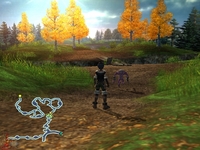|
|

|
BATTLE SYSTEM
|

|
INTERACTION
|

|
ORIGINALITY
|

|
STORY
|

|
MUSIC & SOUND
|

|
VISUALS
|

|
CHALLENGE
|
Varies
|
COMPLETION TIME
|
35-40 hours
|
|
OVERALL
3.5/5
|
Rating definitions
|
|
|
The dream of a smalltown boy leads to an epic adventure in which he becomes the world's salvation and wins the hand of a lovely maiden, or so the story always goes. In Grandia III, Yuki's dream is to become a pilot, not an epic hero who battles legendary monsters. Nevertheless, he flies blindly into a storm of cliches with his mind deadset on his love interest, and crashlands into mediocrity. His only hope lies not in a mystical object, but in the driving force of an awesome battle system that will see everyone through the tough times.
As Grandia games go, the best offering is the battle system -- a process in which players can skillfully and strategically cancel or delay the enemies' attacks, and likewise face a similar punishment from their opponents. Grandia III takes this system to new heights, so to speak. The first obvious cosmetic change is the battle gauge; instead of a bar, it is now circular, like a clock. The second change is the addition of aerial combos. At times, a character can pull off a cancel attack that sends an enemy flying high into the air. Successive attacks from other characters will form aerial combos that heap extra damage upon the enemy as they hang helplessly in midair. This, in addition to the excellence of the classic Grandia battle scheme, makes fighting enjoyable.
There is also an option to allow characters to give each other tips in battle. If one character is being targeted, they will ask for a cancel attack in the form of a special move or a critical hit, or warn another character to defend. Most of the time, this is useful; it can help players adjust to the pace and timing of the battle system. Sometimes it will make a poor suggestion -- prompting a player to defend when a fast special attack will finish off the enemy -- or fail to point out a potential strategy altogether. This at least forces the player to think for himself or herself every now and then instead of relying solely on the game's hints.
 Aerial finish!
Aerial finish!
|
|
Character development has changed as well. These changes are neither improvements nor detractions. Unlike in Grandia II, where power could be bought with special coins, special moves must be leveled up through use in combat. While this means that very useful moves will level up quickly, it also means that moves that are only useful in boss fights will barely improve, unless a player invests time in practicing them on lesser enemies. As for magic, mana eggs are available, but do not bestow a collection of spells upon the user. Instead, characters have to equip individual spells in limited slots. Some spells are available in shops, but some of them are only derived from cracking mana eggs. Stronger spells are from stronger eggs, which require mana egg fusion -- a fun process of experimentation and customization. Fusing different types of elemental eggs creates more powerful mana eggs, which may be equipped to boost a character's magical power or broken to reveal a new spell. Like magic, skills are also earned or derived from skill books, and they must be equipped in limited slots. Skills also allow a degree of character customization. One melee character can become a steady powerhouse, while another can become evasive and quick to counterattack.
The visuals of Grandia III -- shining light beams, falling leaves and snowflakes, dust particles suspended in the air of a forest -- are simply amazing. Screenshots fail to capture the true color and texture of the environments and characters. It is certainly one of the most beautiful titles on the PlayStation 2. Noriyuki Iwadare's music complements the outstanding visuals. The title music, the arrangement of the classic Grandia theme, and the battle themes are excellent. The soundtrack works quite well with the towns, dungeons, and fields, except for one particular tune. The ear-grating instrumentation in a certain town theme is enough to drive a player mad as he or she scrambles for the mute button on the remote. It is supposed to bring Middle Eastern music to mind; instead, it succeeds in imitating the clarinet section of a middle school band. It is, however, the only black spot on an otherwise good soundtrack. Sound effects are largely excellent, although a few enemy sounds are stiff and blatantly artificial. The cast includes some notable voice actors, but some of the spoken lines are rather hollow, and during emotional scenes, the wailing of the female lead may make one pine for the screeching pipes in another town.
 Screenshots just don't do this world justice.
Screenshots just don't do this world justice.
|
|
Sadly, the biggest shortcoming of Grandia III is its story. It begins with so much potential. Yuki is fairly likeable, while his mother Miranda deserves an award for #1 RPG Mom. The story peaks fairly early with some amazing scenes that leave the player expecting things to only get better from here on out. Then suddenly, the plot does a tailspin into tired cliches. There is not much curiosity about what will happen next; plot points come as no surprise when they are revealed. A stellar ending would save the story, but sadly that does not happen. The ending is short, corny, and disappointing aside from the last few heartwarming epilogue tidbits. The Grandia series is not famous for its quality storytelling, but Grandia III should have been better than this.
Along with its somewhat unoriginal story, Grandia III has some other unoriginal content. It has the standard fare of locations – a hot desert, a dense jungle, a majestic holy site, a bustling port town, a sleepy hamlet. The one interesting deviation from the RPG norm, the addition of airplane flight, is not developed enough to be enjoyable. Various gauges and meters tantalize the player until he or she realizes that the airplane is merely a means of getting from one place to another -- no careful piloting skills required, no fancy aerial acrobatics permitted.
There are, however, no complaints about the interface and localization of Grandia III. Players will have no difficulty in navigating the simple menus in and out of battle or reading the circular gauge and damage bars. Likewise, they will have no problems absorbing the mediocre story, as the quality localization makes it painfully clear that the plot is lacking.
Grandia III is a bit more challenging than its predecessors. Battles require the player's full attention and concentration. Letting one's mind stray for a moment, even in regular combat, leads to a missed opportunity to cancel an incoming assault, and that leads to a humiliating defeat. Aside from this and a sudden slap-in-the-face challenging boss midway through the game, the game is generally easy. Excluding resets and do-overs, and assuming the player fights almost all of the enemies in each area, Grandia III will take about 35-40 hours to complete.
Grandia III has its highs -- an outstanding battle system, mesmerizing visuals, and mostly enjoyable music -- and its lows -- mediocre, cliche plot points. These elements combine to create a feeling that there should be less talk and more fighting. Players may find themselves wishing the characters would shut up so they can go back to finishing off enemies with aerial combos. Long-time fans of the series will enjoy the enhancements to the Grandia battle system; newcomers will appreciate the helpful hints tossed out during fights as they adjust to the timing. Grandia III is certainly worth playing, assuming one can endure the disappointing story. As with other Grandia titles, the battle system makes it very worthwhile.
Review Archives
|









